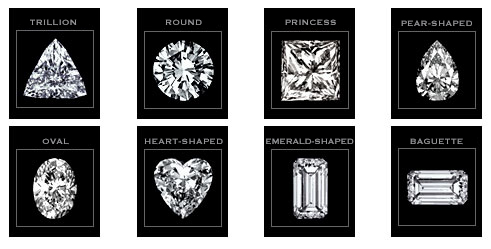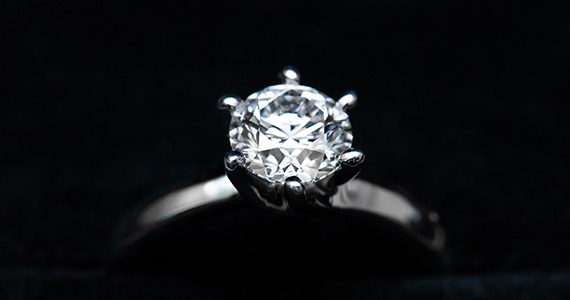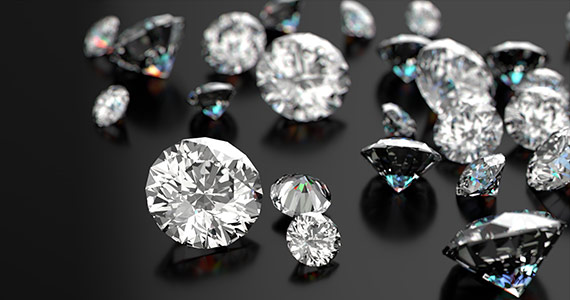Up until some years ago, those who were interested in purchasing a diamond had to blindly trust and rely on the expertise and the honesty of their interlocutor. In the last few years, more rigid criteria of diamond classification have been established worldwide, allowing for an excellent protection of buyers. At the same time the role of the seller, who needs to have expertise and be reliable, remains fundamental in the protection of those who are interested in buying diamonds.
The 4 C’s stand for the four main characteristics with which diamonds are classified:
- Carat
- Colour
- Clarity
- Cut
The weight of the diamond is measured in carats (ct): 1 ct = 0,2 grams.
The colour is classified through a comparison with sample diamonds. For those diamonds that are most commonly on the market, namely diamonds belonging to “Cape Series”, the colour is indicated with a letter, from D to Z, where D means the “whitest” (the most colourless) and Z means that the colour is very yellow, but not yellow enough to be considered a “Fancy Colour”. Proceeding from D to Z, the worth of a Cape Series diamond decreases. The majority of Cape Series diamonds on the market is usually between F and J.
There are “Fancy Colour” diamonds for almost every colour but they are quite rare, therefore their worth is usually greater when compared to a Cape Series diamond with similar weight, clarity and colour classification D.
The clarity of diamond depends on the dimensions and the number of inclusions found inside the gemstone through a lens with 10 magnifications. The clarity is indicated with the following acronyms:

| ACRONYM | MEANING | DESCRIPTION |
|---|---|---|
| IF | Internally Flawless | No inclusions |
| VVS1 / VVS2 | Very Very Small Inclusion | The inclusion is very very hard to see |
| VSI1 /VSI2 | Very Small Inclusion | The inclusion in hard to see |
| SI1 / SI2 | Small Inclusion | The inclusion is easily identified |
| P1 / P2 / P3 | Piqué | The inclusion is visible with the naked eye |
Finally, the cut of the diamond is a characteristic as fundamental as the others mentioned above. It concerns both the shape, the number and the position of the facets (brilliant cut, princess cut, baguette cut, old cut, etc.) and the quality, which is established according to different parameters, among which proportion is the most important.
There are some rigid geometric proportions that must be followed by the cutter, particularly for the brilliant cut, in order to obtain the best diamond in terms of brilliance. The result is that the diameter of two gemstones with the same weight is approximately the same. Here are some examples:

What is the difference between a diamond and a brilliant cut
The answer is pretty easy: the diamond is the raw material, whereas the brilliant cut is a type of cut with 57 facets, 58 if the diamond culet is also faceted.
Furthermore, the brilliant cut can be used for all types of gemstone: for example you might hear about a ruby with a brilliant cut. However, bear in mind that when you only hear brilliant cut, it is implied that we are talking about a diamond with a brilliant cut.
Even if less common, there are other types of cut like Huit-Huit cut, Rose cut, Emerald cut, Carrè cut, Baguette cut, Princess cut and so on.
A brilliant cut diamond does not necessarily have to be round. Therefore you can choose a brilliant cut diamond that can be pear-shaped, heart-shaped, oval, etc.
Some information about diamonds
Diamonds are minerals and, as such, they can be found in nature. They are entirely made of Carbon and they have the same chemical composition of graphite and lead, but since their crystal structure is much more compact, they are very hard. Actually, diamonds are the hardest material we know and the only way to work them is through the use of very specific tools.
It happens quite rarely to find diamonds that are transparent and colourless enough to be used in the jewelry sector: for this reason and because of their hardness, the vast majority of extracted material is used for industrial purposes, while only a small part has those characteristics that are suitable for the jewelry sector.
Currently the biggest diamond producer is Australia, followed by Russia and numerous African states, like for example South Africa, whose mines were the first ones to be exploited.




